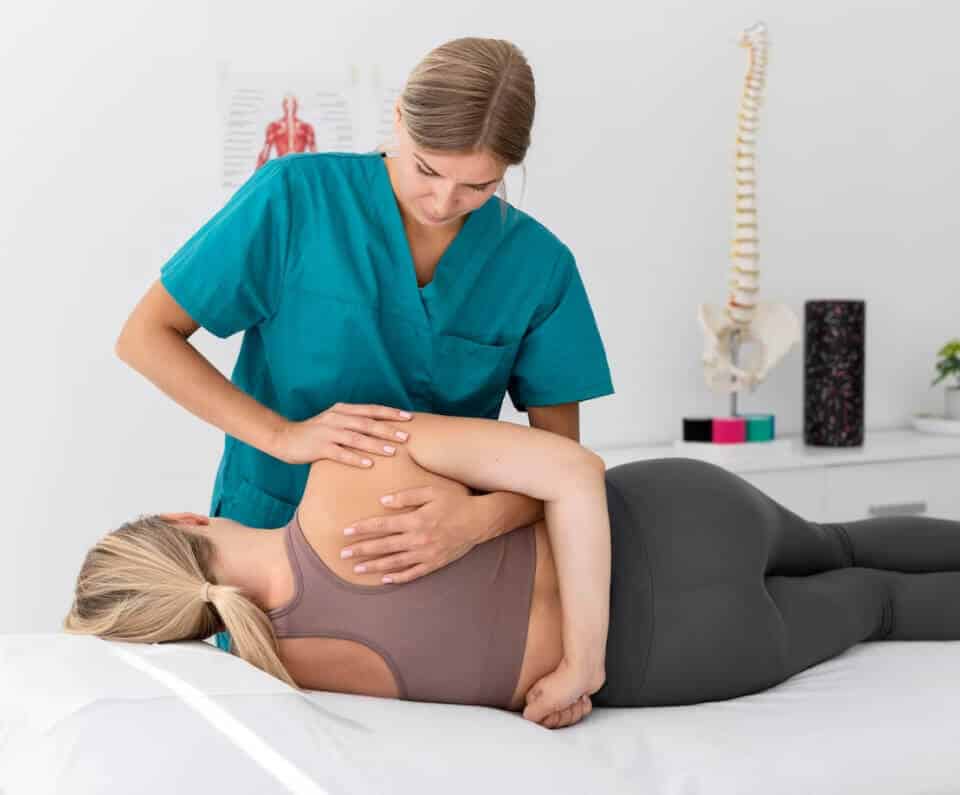
Osteopathy is a manual form of therapy that understands and treats the organism in its holistic structure. It is a philosophy, a science and an art.
As philosophy Osteopathy understands the human being as a holistic being who has all the potential for self-healing and maintaining health. The constant balance between the individual body systems is the optimal prerequisite for health.
As science it incorporates findings from the chemical, physical and biological sciences in the service of health, as well as in the prevention, healing and improvement of diseases. Thus, osteopathy has always endeavoured to scientifically research its activities and successes and to integrate new scientific results into osteopathy.
Your art is to apply philosophical and scientific principles in osteopathic treatment. Osteopathic treatment is based on the knowledge of the many interconnected processes in the organism that lead to health or even to illness.
In order to meet this high standard, osteopaths must not only acquire knowledge of anatomy, physiology and the special diagnostic and therapeutic procedures of osteopathy, they must also have internalised the concept of osteopathy. This is essentially based on four building blocks that determine osteopathic therapists' view of man and thus their conception of medicine.
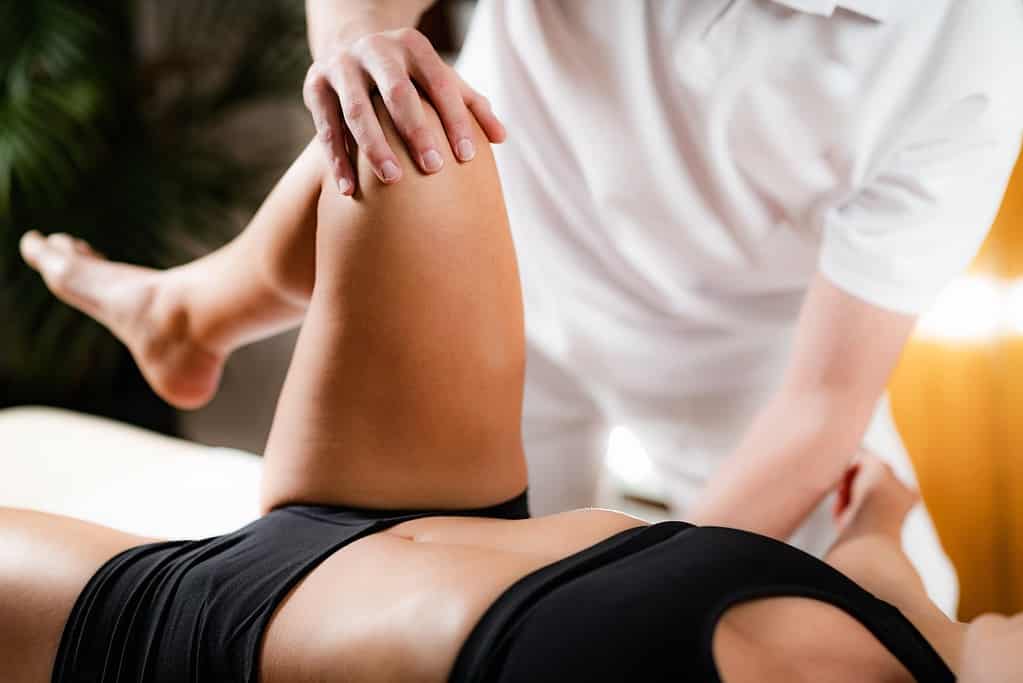

The body is a unit. The human being is a unity of body, soul and spirit and its biosocial/cultural environment.
We see not only the organism with its bones, muscles, tendons, ligaments, fasciae, internal organs, vessels and nerves as a unit, but especially how these tissues relate to the life of the person. Because how a person feels and whether they remain healthy in the long term is influenced by a multitude of physical and mental processes as well as their numerous relationships with their private and professional environment. This includes in particular their lifestyle, i.e. their dietary habits, their exercise habits, their sleep, etc.
From an osteopathic perspective, for example, there is no strict separation between physical and psychological complaints. On the contrary, we are interested in the close interaction between your life and your body.
All these factors are inextricably linked. These connections are essential for successful treatment. That is why we treat you holistically at the Liem Osteopathy Centre. This means that we take a detailed anamnesis that encompasses all of your life.
That is why Mr Liem, as one of the first osteopaths in Germany, constantly ensures further training for all colleagues in the osteopathy centre. Through constant training and further development, we are, for example, in the best position to incorporate the latest scientific findings into the treatment.
Structure and function influence each other reciprocally.
Body structures in the osteopathic sense are bones, muscles, fasciae, ligaments, tendons, organs, nerves, vessels, as well as the body fluids (e.g. blood, lymph, cerebrospinal fluid).
Functions are the physiological processes such as body movements, blood circulation, digestion or the menstrual cycle of women or thought processes and feelings. Structures and functions are closely interrelated and constantly influence each other.
Let's take the elbow joint as an example. This is made up of three partial joints. Each of these partial joints (structure) allows certain movements (function). For example, the forearm can be bent and stretched in the upper arm-elbow joint (a hinge joint) in relation to the upper arm.
There is also the upper arm-spoke joint and the ulna-spoke joint.

Thus the elbow joint is also functionally involved in turning movements of the hand.
If the function changes, e.g. by overdoing it, for example when playing the piano or screwing the garden shed or playing tennis, the structure suffers. Attachment points of muscles to the bone can then become inflamed, for example. But these processes can also be influenced by other joints that are not even in the place where it then hurts, e.g. the shoulder joint, the cervical spine or even the diaphragm, the organs or the abdominal muscles. These so-called dysfunctional chains are based on the osteopathic concept of somatic dysfunction.
The susceptibility to inflammations forming or healing poorly is also influenced by dietary habits.
The ability to "read" this interplay determines the extent to which we, as your osteopaths, can actually treat appropriately.

Each model includes anatomical, physiological and psychological factors. The osteopath has all these models in "view" and in "hands" when people come for treatment.
The osteopath assesses the extent to which the self-regulatory forces are exposed to possible stresses and supports them, for example, by releasing dysfunctional tissue tensions and the finest movement restrictions, so-called osteopathic or somatic dysfunctions.
At the same time, the treatment is always oriented towards the self-regulating forces expressed in the body and the globality of the patient, e.g. in which the osteopath synchronises with the body's own rhythmicities, and in which what is going well is appreciated and reinforced.
Osteopathic treatment follows the first three principles. It takes equal account of the unity of the body as well as the knowledge of the self-healing powers and the interrelationships between structures and functions.
Health is always in process and our understanding of health is also constantly changing. Osteopathy as a healing art should take into account the individuality of health in every person. Against this background, being ill means having a disturbed relationship to oneself as well as to one's fellow human beings and one's environment.
As osteopaths, we focus our attention on these self-healing processes. In practice, we support these body's own regulatory mechanisms through our hands using osteopathic techniques. We also help to understand the voices of the symptoms and possibly adjust the lifestyle accordingly so that symptoms are no longer necessary.

For osteopaths, the organism and the human being as a whole represent a unity. Each of the following sub-areas influences the others. They cannot be considered separately from each other. The distinction is purely didactic because all body systems are interconnected and act in continuous interaction with each other to ensure health and life.
This refers to the musculoskeletal system, the muscular-fascial system. Movement restrictions caused by abnormal positions of muscles, joints, ligaments and fasciae (= connective tissue covering of muscles) can be corrected by targeted impulses. A new static and dynamic balance is re-established in the body. For example, pelvic obliquities, misalignments of the vertebrae, muscle tensions or the consequences of a twisted foot that have remained in the body's memory can be corrected if they are the cause of disorders.

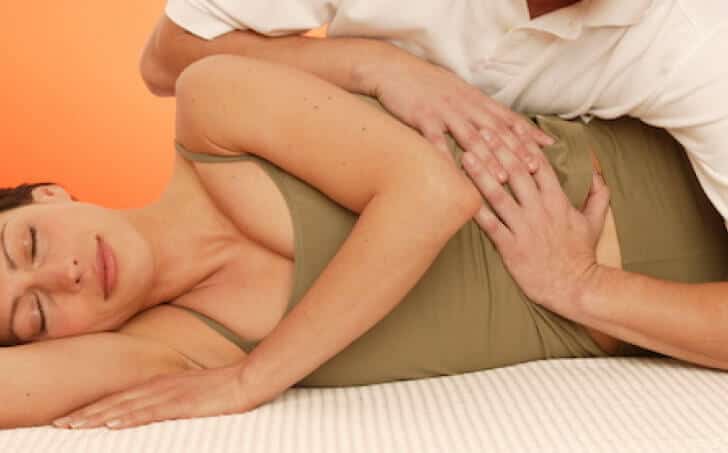
This refers to the internal organs: stomach, intestines, liver, kidneys, lungs, heart, etc. The rhythmic self-movement of the organs and their ligamentous and fascial connections are treated. The nervous supply, the blood circulation and the function of each organ can be normalised. Digestive disorders can be resolved in this way, detoxification processes can be initiated and metabolic disorders harmonised so that the organism can recover. Here are some of our publications in this field:
The word "craniosacral" is composed of the Latin terms for skull (cranium) and sacrum (sacrum) and at the same time designates the area of the body that is particularly focussed on here.
The craniosacral system includes the brain, the cerebrospinal fluid, the meninges, the cranial bones and the sacrum. In particular, headaches and disorders of the sensory organs, visual, swallowing and jaw disorders, middle ear and sinusitis, are localised in the area of the cranium.
However, disorders are always treated by osteopaths taking into account all areas of osteopathy. This is because osteopathy focuses on the interrelationships of the human being and not on individual areas.
At the same time, craniosacral osteopathy also refers to certain treatment approaches. It is characterised, for example, by the osteopath's synchronisation with micro-movements in the various tissues of the body. This approach was first developed by William G Sutherland and further developed by Torsten Liem, among others. Here are some of our publications in this field:
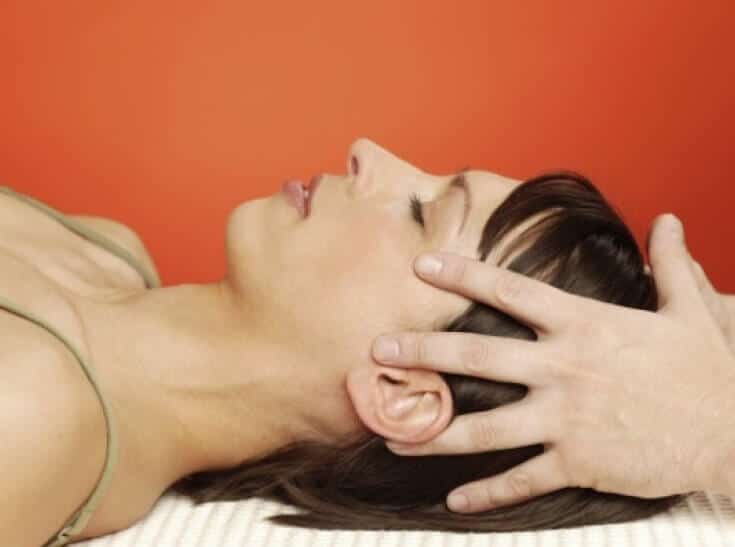
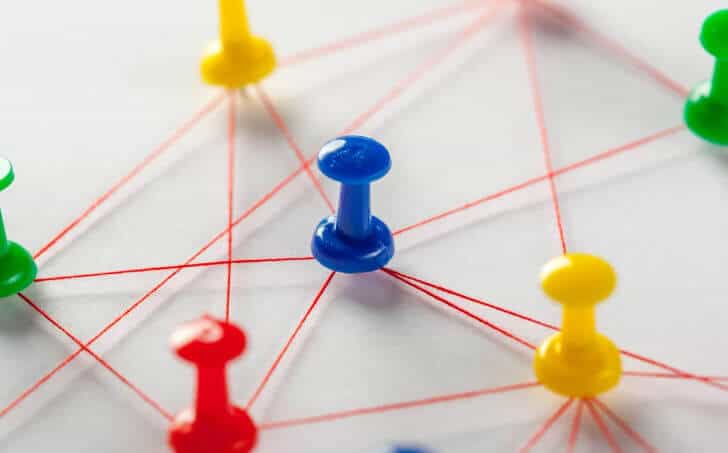
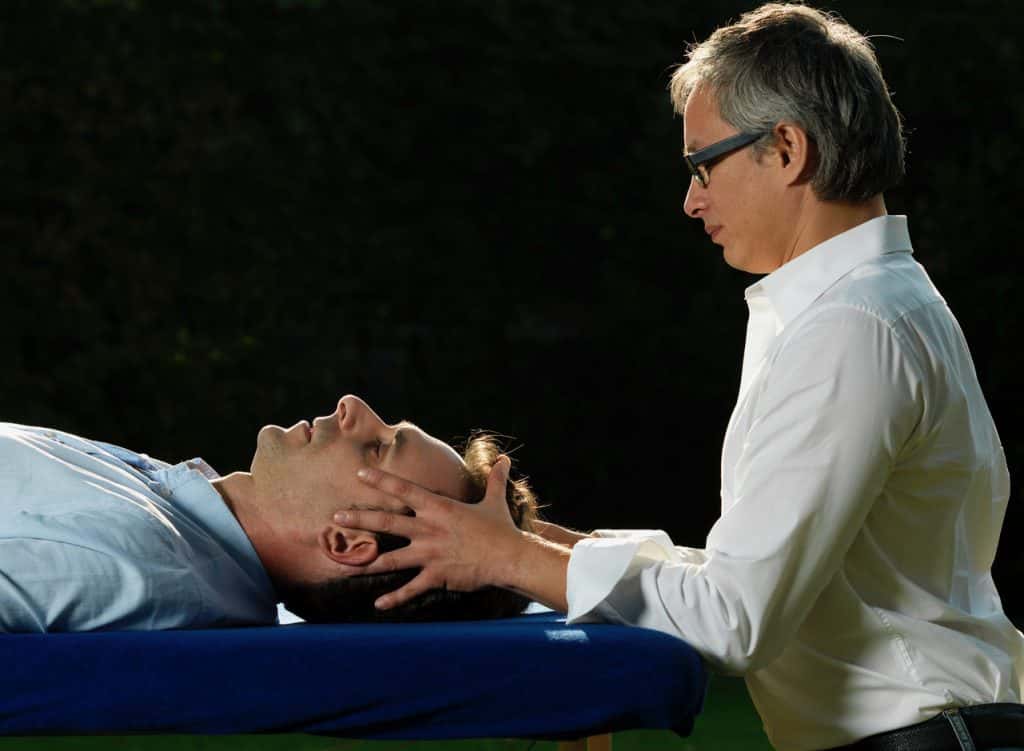
We can be exposed to different types of stress in the course of our lives: physical, emotional, social, biochemical, metabolic, electromagnetic or pathogenic (bacteria, viruses, fungi, parasites) stress factors or toxins/environmental pollution. Our lifestyle also plays a major role here. First of all, our organism tries to dissolve possible stress factors. If this is not possible, we adapt. This is achieved through a variety of adaptive and physiological changes, also at the tissue level. This is called allostatic adaptation.
However, this allostatic adaptation itself represents a certain challenge and burden for the body and is called allostatic load. Depending on how long and how intensively the stress factors affect us, and depending on how susceptible we are to them, our self-regulatory forces of adaptation exhaust themselves and further chains of consequences develop in the body. From this perspective, complaints can also be understood in part as a deficit of dynamic interaction within the adaptive systems themselves and between them.
Our body shows this through symptoms such as pain or discomfort, etc.
For an experienced osteopath, this becomes recognisable in the change in the relationship between structure and function, long before the individual systems or structures suffer more severe damage.
The five osteopathic models are based on the above-mentioned viewpoints, which correspond to an osteopathic-salutogenetic approach.
Salutogenesis examines factors that are crucial for people to develop towards health. The affinity of the osteopathic approach is strikingly expressed in a quote from Still, the founder of osteopathy: "To find health should be the object of the doctor. Anyone can find disease".
Osteopathy is always focused on the individual person. Modern osteopathy understands that it is rarely a single factor and usually, always combinations of factors in a patient's life history. Taking these factors into account is important for understanding and resolving his complaints.
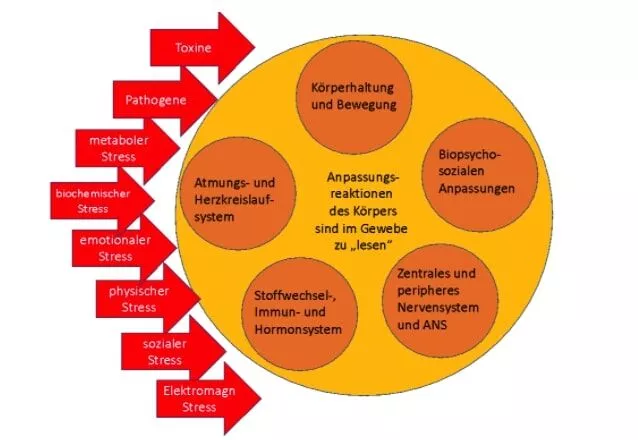
Movement is the most significant characteristic and prerequisite for life.
From birth, humans are exposed to stresses that can affect their balance: Stress, infections, poor nutrition, emotional stress and trauma, accidents...Movement is the most significant characteristic and prerequisite for life. From birth, humans are exposed to stresses that can affect their balance: Stress, infections, poor nutrition, emotional stress and trauma, accidents....
If these influences are too strong to be "digested" and dissolved by the organism, it has to come to terms with themThis causes changes in posture, the function of certain organs, the hormonal or nervous system. This reduces the movement and mobility of the tissues, so that fluids such as blood or lymph can no longer flow freely. The result is a restriction of the supply of nutrients and oxygen in the body as well as a reduced removal of metabolites in the tissue and a disturbed nerve supply. If the organism's ability to compensate is permanently overtaxed and its postural pattern and its entire system are overly stressed, diseases develop.
Still applied tissue techniques to relieve pressure on nerves, arteries, veins and lymph vessels, thereby re-establishing the conditions for healthy physiology. Even today, the aim of osteopathic treatment is to help the organism to restore the communication of the body fluids and the nerve impulses as well as the harmonious movement and mobility of the tissues. Ultimately, therefore, the body heals itself and the osteopath supports it in this process.
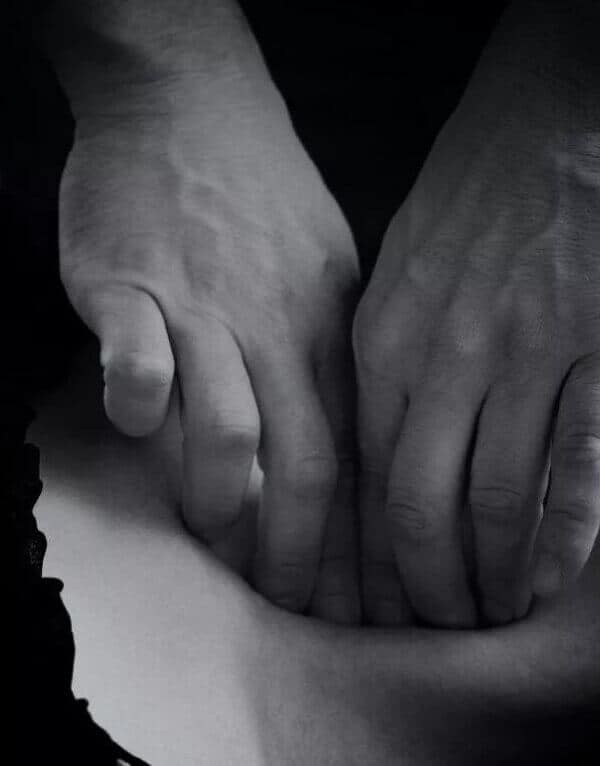
Her art is to apply philosophical and scientific principles to osteopathic treatment.
Osteopathic treatment is based on the knowledge of the many interconnected processes in the organism that lead to health or illness.
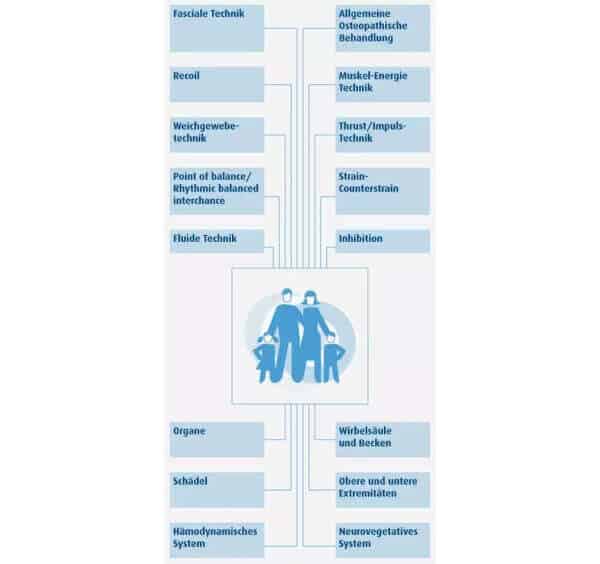
Techniques Osteopathy - The osteopath should be able to touch very precisely joints (incl. cranial sutures), muscles, ligaments, fasciae, organs, nerves, vessels, body fluids and energies and diagnose and treat their interrelationships with other tissues.
Osteopathy is characterised by the practitioner's ability to develop his or her own techniques that are best adapted to the patient's age and characteristics. Nevertheless, there are different approaches to techniques. Some of these are presented below.
From the point of view of osteopathy, symptoms of illness are always associated with changes in tissue tension or mobility.
The osteopath can already detect and treat such changes before the patient even notices a restriction of movement or before clear symptoms of illness appear. Osteopathy is therefore also used when there are disturbances in the patient's condition - long before a disease can be diagnosed.
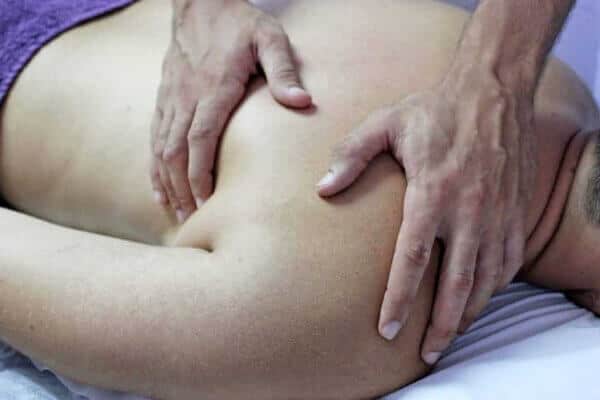
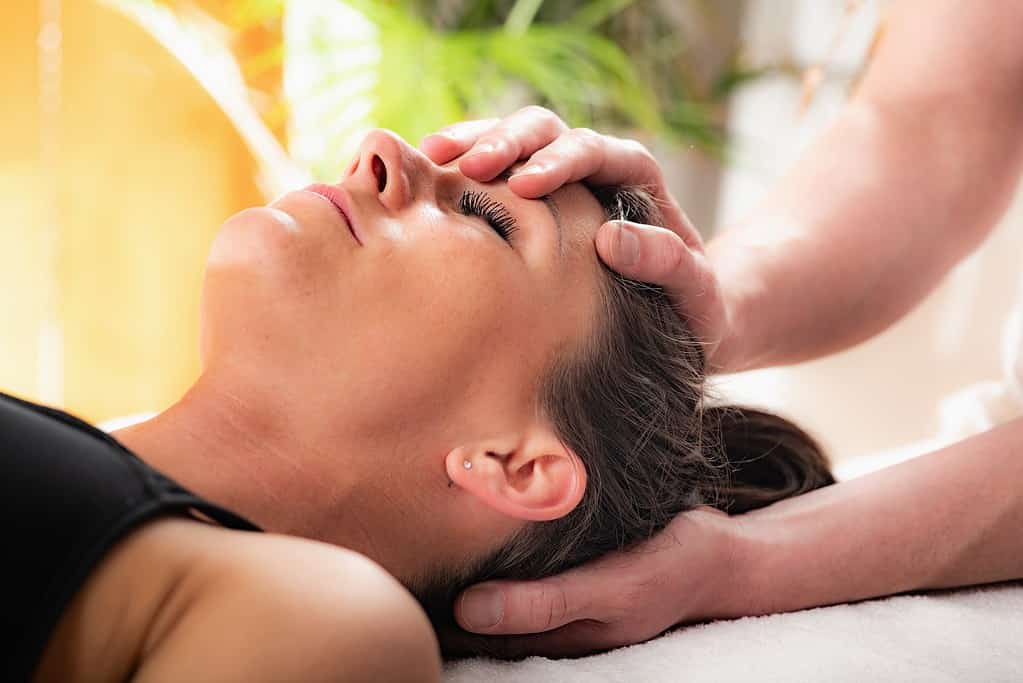
Osteopathy is the law of mind, substance and movement. It was founded about 120 years ago by the American physician Dr Andrew Taylor Still (1828-1917). This extraordinary man began his search for a new, holistic way of therapy because he was deeply disappointed by the medicine of his time. His first wife and six of his children died of infections that they could have survived if they had been treated properly.
Through years of research, Still had recognised that the human being reacts as a unit in health and illness. He knew about the interactions of the organ systems and knew the laws of nature. On this basis he developed a holistic treatment concept. From the beginning, the treatment was carried out exclusively with the hands.
Still found that every obstruction of nervous and vascular structures and every restriction of movement and increased tension of tissues forms the basis for the development of disease. By resolving these disturbances, he was able to improve or completely dissolve functional disturbances even in more distant parts of the body.
In 1892 Still founded the "American School of Osteopathy" in Kirksville. Since that time, osteopathy has continued to develop. William Garner Sutherland, for example, extended the principles of osteopathy to the skull and gave osteopathic teaching a multitude of further impulses.
The French osteopath Jean Pierre Barral was one of the first in recent times to establish the scientific basis for the treatment of the internal organs.
The American osteopaths achieved legal recognition of their profession and equal status with medical doctors after long disputes. John Martin Littlejohn brought osteopathy to Europe as early as 1917. In 1951, the Ecole Francaise d Osteopathie was founded in Paris. In 1965, due to state repressive measures, it emigrated to England, where it was renamed the European School of Osteopathy (ESO) four years later. In England, osteopathy has been recognised as a university course for several years.
Even though osteopathy is still a young therapeutic method in Germany, osteopathy is therefore not a new, perhaps dubious doctrine of healing, but a holistic procedure on a solid foundation.
With my blog I would like to make the field of holistic health consisting of expert knowledge and practical insights on MIND, BODY and LIFESTYLE accessible to the general public.
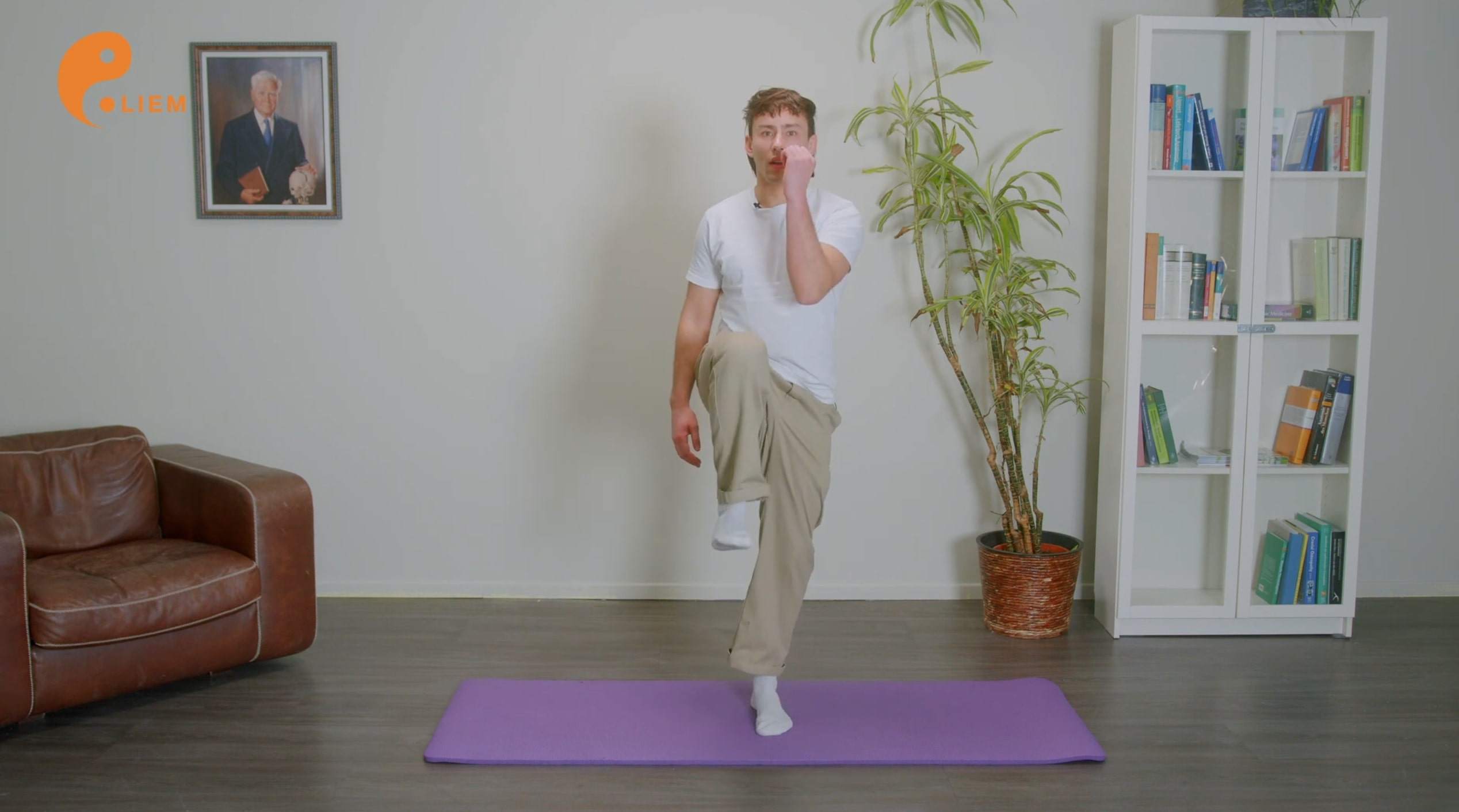
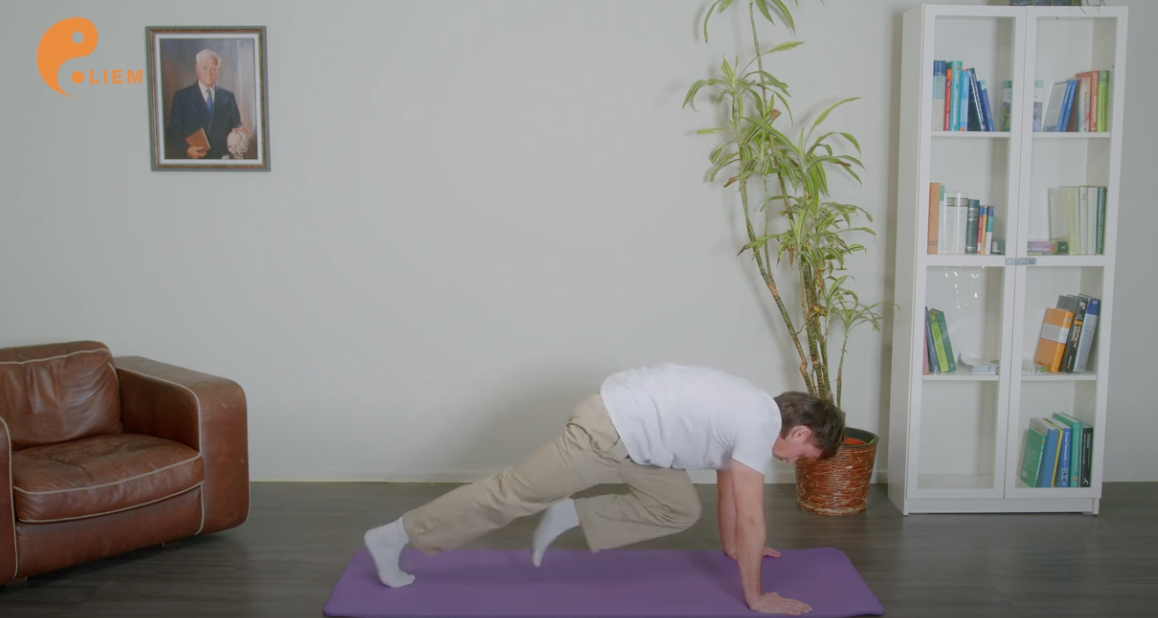
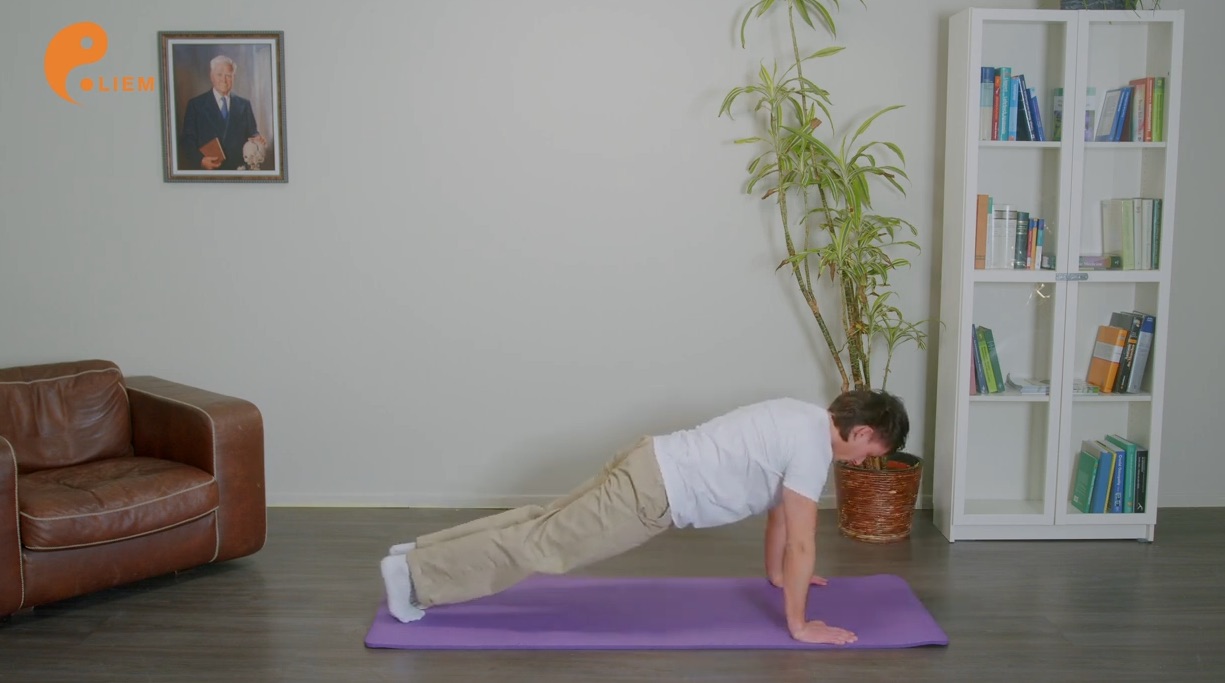
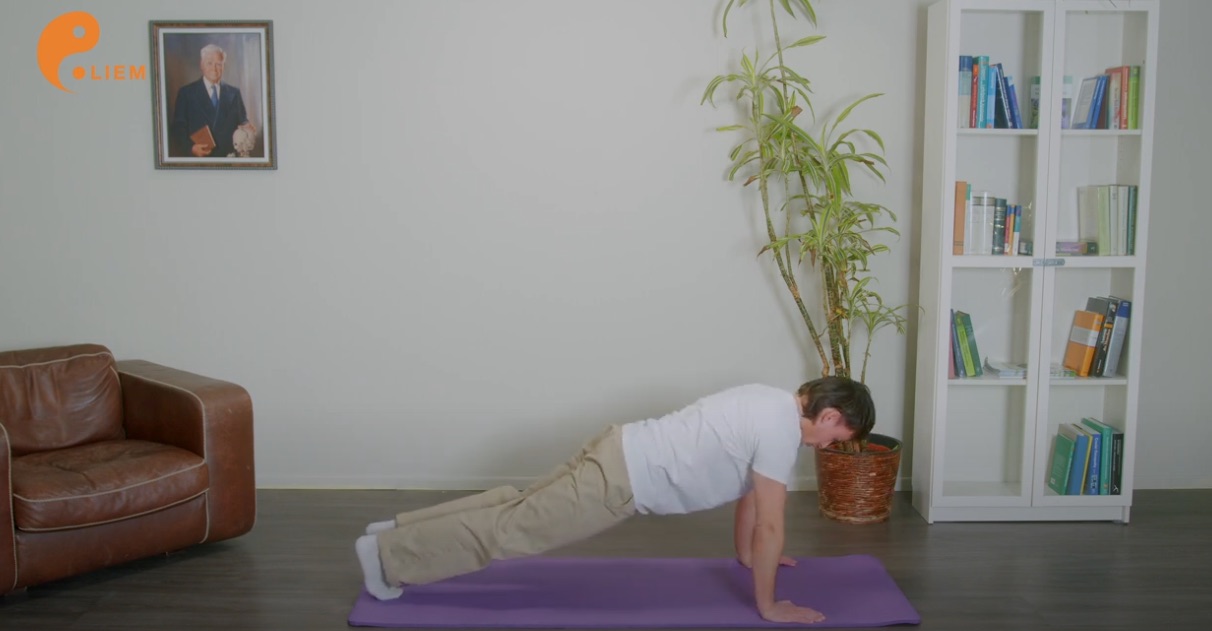
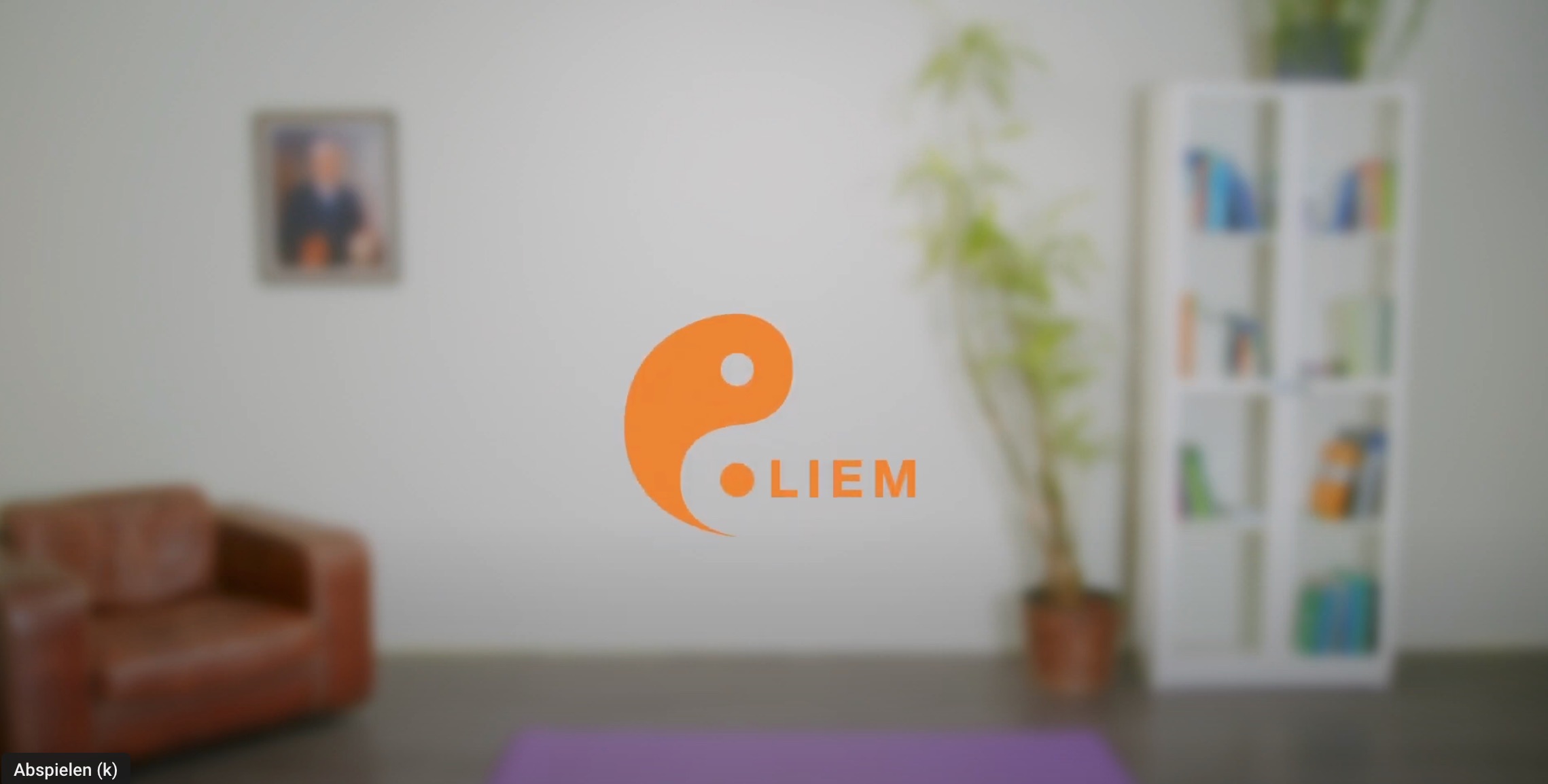
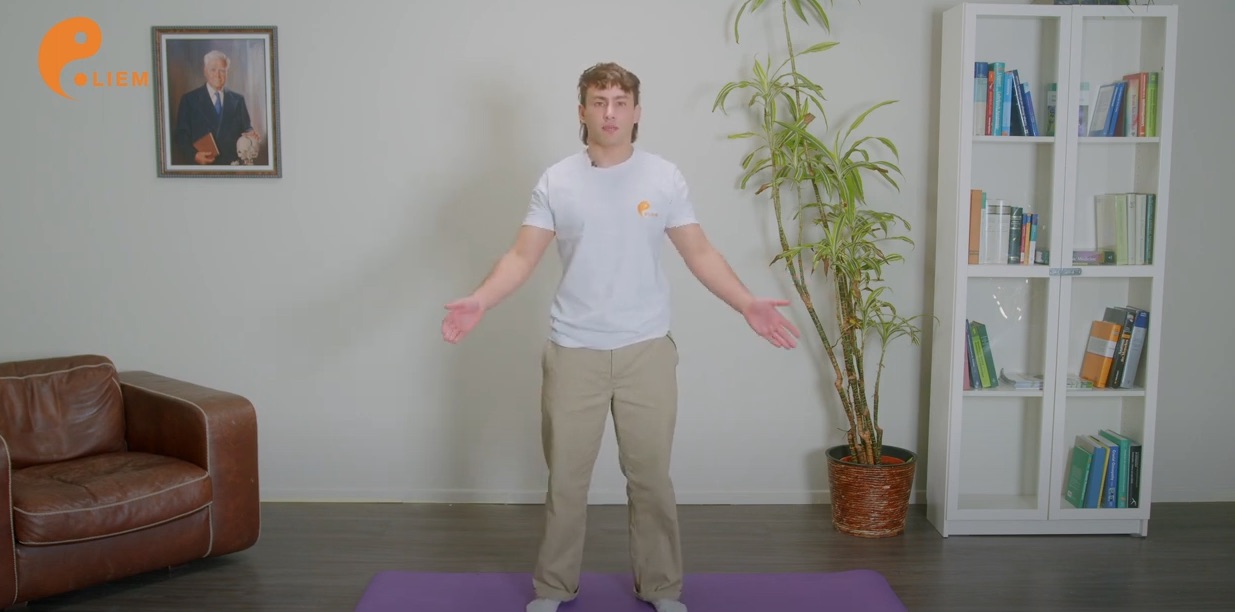
Liem Osteopathy Centre
Frahmredder 16
22393 Hamburg
Wir rufen Sie zurück!